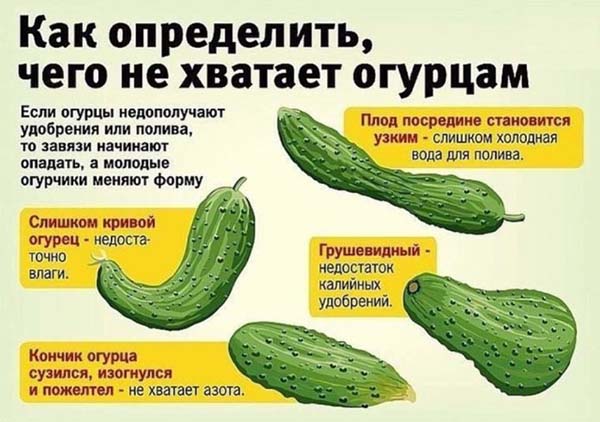Cucumbers are crooked or crocheted: reasons and what to do, how to feed
Ideally, cucumbers should grow even (have the same thickness along the entire length of the fruit) and straight. However, they often grow in irregular shapes: crooked, hooked, in short, deformed.
Next, we will name the main reasons why cucumbers grow in curves, namely, how you can independently visually determine what the cucumbers lack, how they need to be fed, or how to change the conditions for their maintenance and care so that the greens grow in the correct shape.
Advice from a seasoned fisherman: when you have hook cucumbers - it's time to go fishing, take lightly salted hooks for a snack 😉
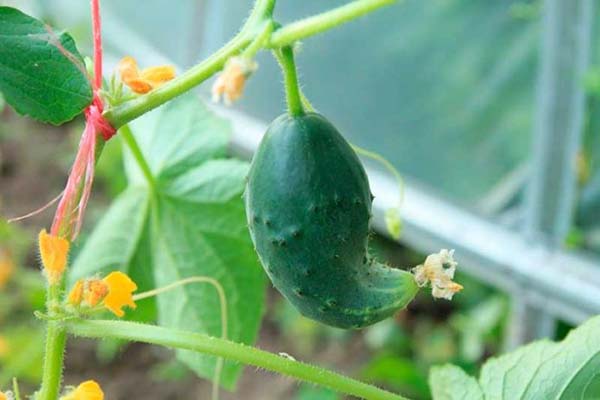
Content
Why cucumbers grow crooked: reasons
Conventionally, the main reasons why cucumbers are curved can be divided into the following 2 groups:
- lack of nutrition (macronutrients - nitrogen or potassium);
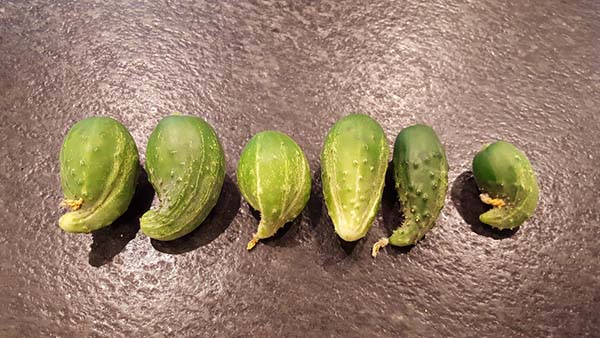
- improper watering (insufficient watering or watering with cold water).
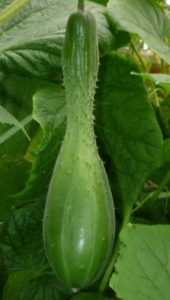 Also, cucumbers can grow crooked due to:
Also, cucumbers can grow crooked due to:
- insufficient pollination of bee-pollinated varieties;
- pollination of parthenocarpic hybrids by pollinating insects (bees);
- late collection of fruits;
- adverse weather conditions.
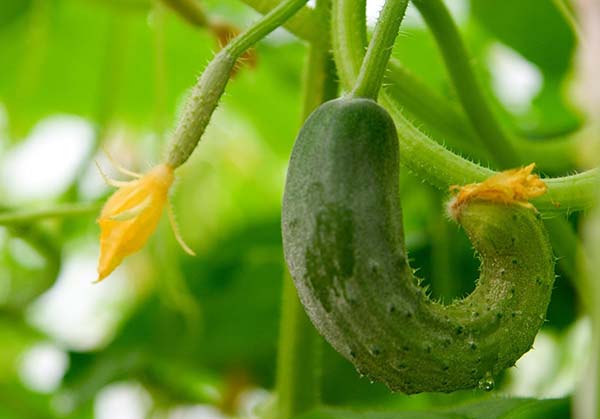
By the way! Hookiness is especially inherent in long hybrids and varieties of cucumbers, in particular Chinese... This is a kind of varietal feature.
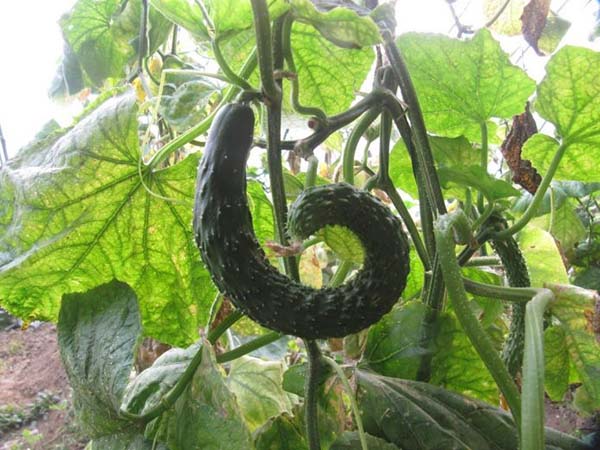
Lack of nutrition: lack of macronutrients (how and how to properly feed cucumbers)
One of the main reasons that cucumbers grow irregularly shaped is the lack of one or more nutrients in the soil.
Also, the curvature (curvature) of zelents can be caused general nutritional deficiencies (so to speak, "everything is missing").
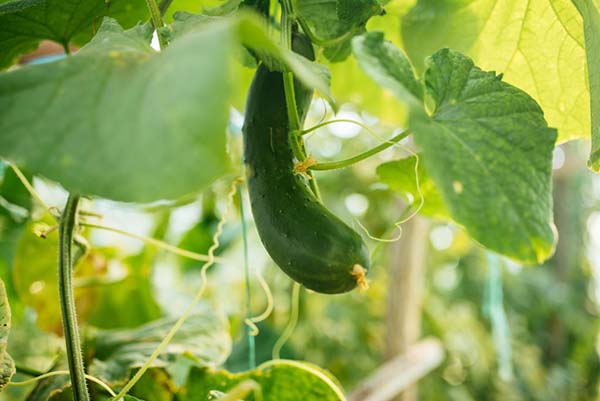
By the way! The site has a detailed article about how to properly feed cucumbers.
Lack of nitrogen
It is possible to determine that cucumbers are experiencing nitrogen starvation by the following signs:
- old lower leaves turn yellow, acquiring a light color;
- young leaves stop growing;
- naturally, special attention is drawn to the form of zelents: cucumbers are deformed, namely, decrease in diameter and sharpen towards the end, their top (the place of flower attachment) sharpens.
By the way! Often tips curved cucumbers also turn yellow.
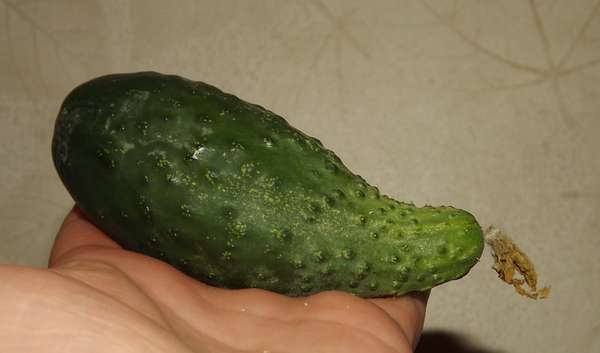
Also, the fruits lose their dark green color, becoming paler (light green).
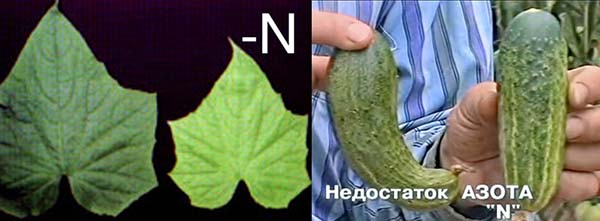
What to do if the cucumbers are bent downwards, how to feed them?
It is quite obvious that nitrogen fertilizers, which include the following:
- ammonium nitrate;
- urea (carbamide);
- green fertilizer (infusion of herbs, the same nettle);
- a solution of mullein or chicken droppings.
Lack of potassium
In case the plant lacks potassium, the situation is reversed:
- cucumbers are deformed in the opposite direction, i.e. they have narrowing of the fruit at the base (at the place of attachment of the stalk), and to the top (nose) cucumbers, on the contrary, thicken. As a result, Zelentsy acquire club-shaped or pear-shaped (they also say that cucumbers have become like Ilyich's light bulb).
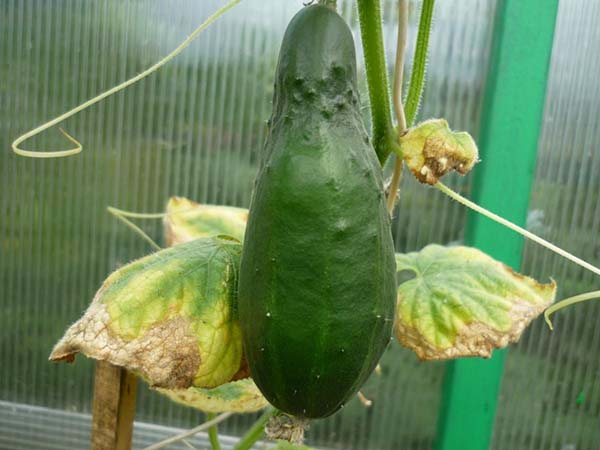
In addition to deformation, potassium starvation is also reflected in the appearance of the plant (leaf apparatus):
- Old lower leaves of cucumber turn yellow at the edges (they remain green in the center), i.e. they have yellow border (marginal chlorosis).
- Wherein young leaves become reduced sizeshave dull color and take a bowl shape.
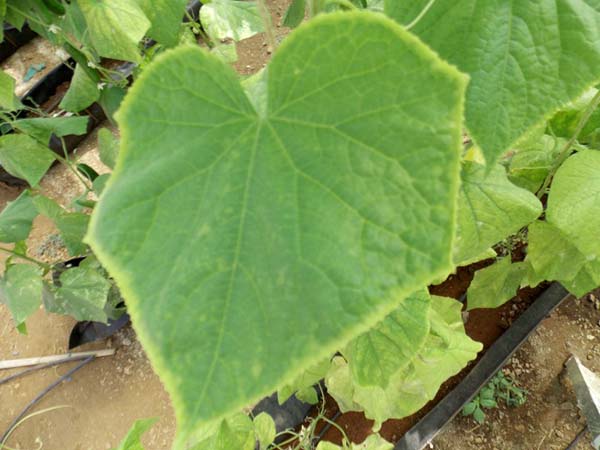
The same should be done if the cucumbers are bent upward, how to feed?
It is recommended to feed one of the following potash fertilizers, which include:
Advice! Potassium fertilizers are very quickly washed out of the soil, especially since cucumbers require frequent watering, so fertilizing with potash fertilizers should be performed regularly.
- potassium nitrate (also contains nitrogen),
- potassium sulfate (potassium sulfate);
- potassium monophosphate (contains even more phosphorus than potassium);
- potassium magnesium (also contains magnesium);
- wood ash (also contains phosphorus, calcium, magnesium and other trace elements).
Note! It should be understood that the yellow border from the leaves will not disappear anywhere, as well as cucumbers will not become smooth and straight... The main thing is that the plant in the future will receive sufficient nutrition so that all the upper and newer leaves do not turn yellow at the edges, and the fruits do not bend.
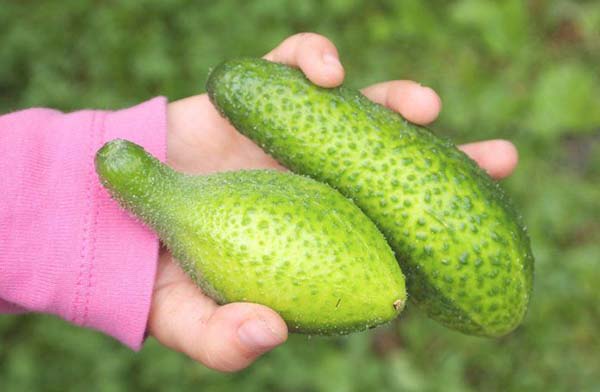
Lack of phosphorus
Important! Lack of phosphorus does not lead to curvature of cucumber fruits, however, in this case they acquire an unnatural dark color. Also, phosphorus starvation is often accompanied by dropping of ovaries and color change leaves to purplish (with a purple or lilac tint).
Video: crooked cucumbers - causes and their elimination (lack of nitrogen and potassium)
How to feed properly to make up for macronutrient deficiencies
Depending on the method of application, all plant nutrition can be divided into:
- root;
- foliar.
Root top dressing implies that you apply the fertilizer directly to the plant's root system.
Advice! It is recommended to perform liquid root dressings after rain or watering (otherwise they can burn the plant roots), in the evening or on a cloudy day.
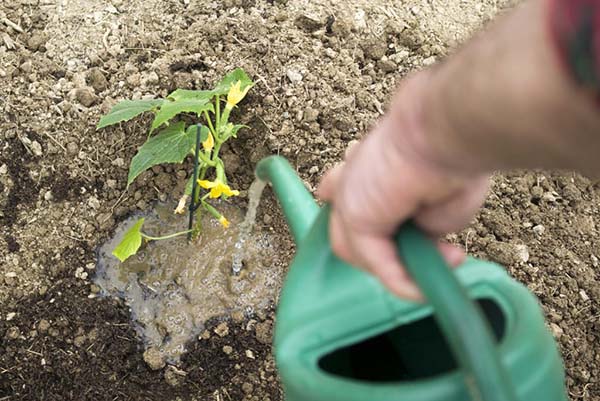
Foliar top dressing is carried out by spraying the plant on its leaves.
- They are most effective if the weather is not hot and the temperature has been low for a sufficiently long time. In such conditions, the root system may not cope with feeding and not assimilate it, unlike the leaves of cucumbers.
- Spraying in the open field need to carry out in the evening or in cloudy weather, unless rain is expected, otherwise they will simply wash off all the fertilizer.
- To the greenhouse rain can't get, but the sun's rays should never fall on the treated leavesotherwise they can cause burns.
Important! To perform spraying on foliage, solutions of lower concentration should be prepared, as a rule, 2 times.
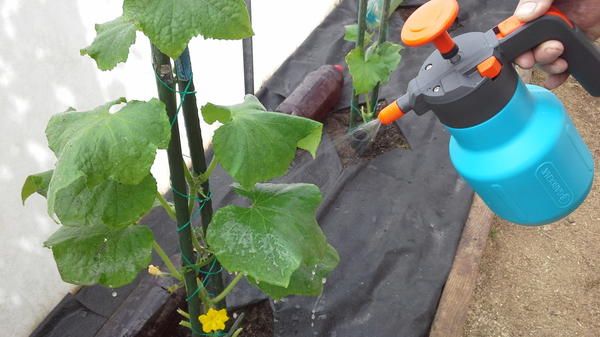
By the way! The site has a detailed article about how to feed cucumbers correctly during fruiting.
Violations of the rules for watering cucumbers
You need to water the cucumbers correctly. Moreover, due to violations of the irrigation regime, cucumbers can become not only crooked, but also start to taste bitter.
Advice! The site has material about when and how to properly water cucumbers in a greenhouse and open field.
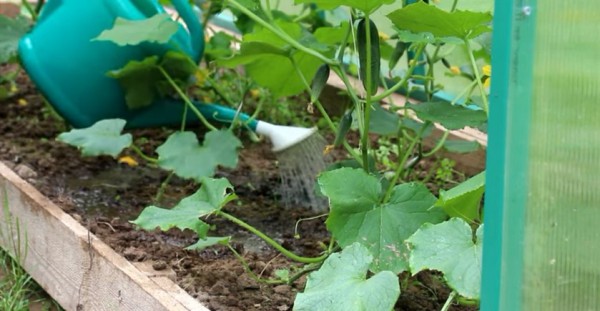
Insufficient watering
If your cucumbers look like hooks (acquired a hook-like shape), then, most likely, the matter is in insufficient watering.
By the way! Due to lack of moisture, cucumbers can also become bitter.
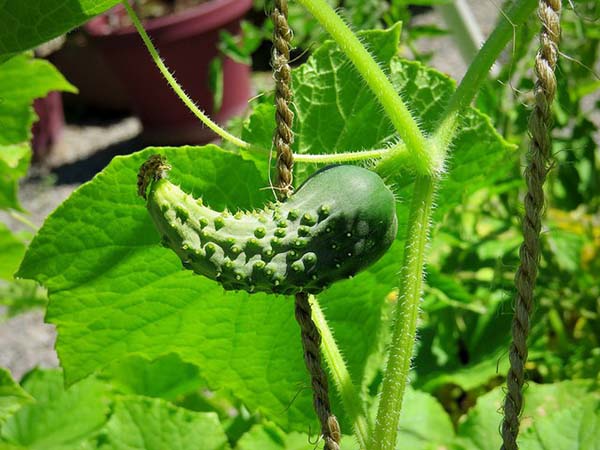
And also because of drying out of the soil and rare watering cucumbers can purchase barrel-shaped.
How often and how much to water the cucumbers:
- The watering rate for cucumbers is 2-5 liters per plant, depending on its size (at the beginning of the growing season - less, during the period of growth and fruiting - more) and the type of soil.
- Watering frequency is every day in dry and hot weather, every other day or two in other cases.
Watering with cold water
Another reason why cucumbers can become crooked, more precisely, narrow in the middle, is watering with cold water.
Also, a constriction on the fruit can form due to irregular watering (alternation of normal and insufficient soil moisture).
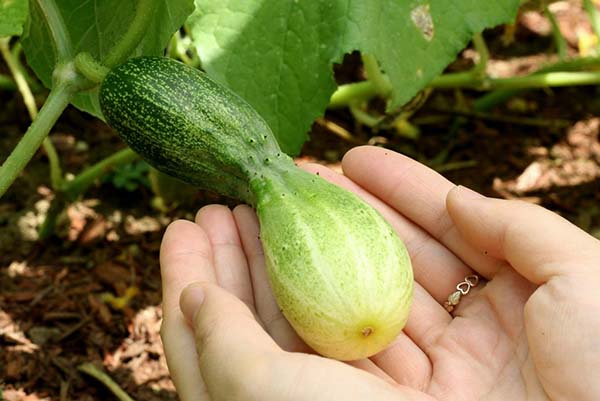
You need to water cucumbers only with warm water (not lower than +16, optimally - + 20-25 degrees):
- It is strictly forbidden to water cucumbers with ice water from a well or well.
- When they say "warm", this does not mean at all that the water needs to be specially heated somehow. It is enough if your container of water will stand in the sun or in a greenhouse.
Other reasons causing deformation of zelents
Insufficient pollination
Poor or incomplete pollination bee-pollinated varieties is the reason for having pear-shaped or pomegranate-like zelents (as with a lack of potassium).
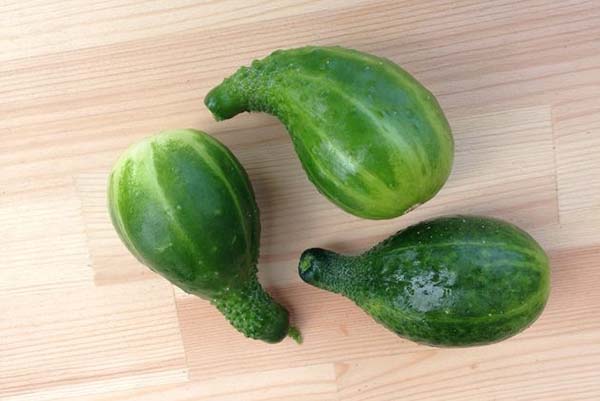
Somewhat less often, insufficient pollination in bee-pollinated varieties can cause deformations similar to nitrogen deficiency, i.e. cucumbers will be pointed (wedge-shaped).
Why can cucumbers pollinate poorly?
- The main factors that reduce years and the activity of bees (pollinators) are cloudy weather and rain.
- Temperatures that are too cold or too high (extreme weather conditions) also negatively affect the viability of the pollen.
Pollinationparthenocarpic cucumber
Do not grow in one greenhouse (or on one garden bed) parthenocarpic (not requiring pollination) and bee-pollinated cucumbers. Otherwise, with such a joint planting, the greens will turn out to be crooked, ugly and, as a rule, pear-shaped (bottle) shape (as in the case of a lack of potassium).
The thing is that pollinating insects (bees, bumblebees) will pollinate and flowers parthenocarpic cucumbers, who don't need it and will only harm, namely, due to pollination, the seeds will be tied unevenly throughout the fruit (seed chambers will not form properly), which is why the cucumbers will turn out to be "clumsy".
Advice! Therefore, in summer greenhouses and greenhouses with constantly open ends and transoms through which bees fly freely, and even more so in open ground, it is better to plant ordinary bee-pollinated varietieswhich, when pollinated, give even fruits.
Or plant only parthenocarpic hybrids or bee-pollinated varieties.
Late collection of fruits
In some cases, if you leave large overgrown fruits on the plant, this can cause deformation of young green plants and they will become similar in shape to "barrels" (as with insufficient and rare watering).
Thickened plantings and lack of light
Another common reason for the curvature of zelents.
The solution is simple: plant seedlings initially or plant seeds at a sufficient distance, and afterwards on time stepchild and pinch cucumber lashes.
Unfavorable weather conditions: low temperatures
This reason is, rather, of an auxiliary character, namely, because of low temperatures, cucumber plants simply begin to absorb less macronutrients, the same nitrogen, potassium and phosphorus, which is why their deformation occurs. And if, in addition, you water the cucumbers with cold water ...
Due to constant temperature changes in cucumbers, bitterness.
What can be done in this situation?
In the open field, except for mulching (mulch, in addition to creating warmer conditions, will also be better to retain moisture and protect plantings from weeds). But in the greenhouse - there are options:
- put bottles with warm water (will serve as a heat accumulator);
- close early at night, and open doors and vents later in the morning;
- put a heater in the greenhouse.
This way, now you know what to do if the cucumbers grow crooked. Good harvests and beautiful green plants!
Advice! Save this picture for yourself in order to visually navigate the causes of the curvature of the cucumbers and immediately determine what they are missing - fertilizer or watering.
